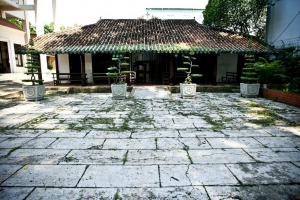Visit Tan Xa, the oldest house in Sai Gon
The chapel (now called Tan Xa) locating at 180 Nguyen Dinh Chieu Street, in the campus of the bishop’s palace in District is considered as the oldest house in HCM City today. In 1790, Nguyen Anh, (Gia Long King) built a bamboo house covering-thatched roof on the right bank of Thi Nghe Canal. It was here that the Bishop tutored one of Nguyen Anh’s sons, the Prince Canh, who lived on-site.
In 1799, after losing Pigneau Pierre, a French bishop and others have to replace in the house, but between 1811 and 1864, the Hue court banned a Catholic, the house was closed. The story of how the French came to be presented with the house is well known. It was given in gratitude for their role in the suppression of the Tay Son rebellion, which resulted in the consolidation of the power of the Nguyen Dynasty in the recently settled lands of the south.

The beleaguered King Nguyen Anh had taken refuge in Thailand, where he had gained the support of the Thais. When the Thai army that entered Vietnam was routed by the Tay Son troops in just two days, there was no alternative now but to accept the French offer of their military intervention in order to save the day.
During the reign of Tu Duc, Mr. King has signed a peace treaty with France to expand the Zoological and Botanical gardens in Thi Nghe parish, the house was transferred to a spot near what is now the Reunification Palace. It was only in 1911 that it was relocated once again to to current location Time it is used as a chapel.

The chapel is built in the traditional architectural style, with three compartments and two lean-tos. Systems and roof tiles ruong short yang has formed an architecture with traditional wood Vietnam walls are thin slats of wood are arranged perpendicular. The wooden walls are not only a role for home protection but also a great ventilation system.

Later in 1945, the wall termite eaten wood has been replaced by brick. During remodeling in 1980, workers replaced the interior of the wooden termite feeding by pouring concrete into. Part exterior wood columns remain; they still seem to look ancient. The workers also had to raise the base column 30 cm. Until now, the Archbishop's Palace is 103 years old while the chapel is 215 years old.
Much is to be learnt from viewing this well restored house, because its original condition has remained unchanged. Coming Ho Chi Minh City, travelers still not forget to visit and contemplate the beauty of the chapel.
2015 -2016 VietNam Tour Promotions
Our Favourites
- Viet Nam
- Laos
- Cambodia
- Thailand
- Myanmar

Da Nang International Fireworks Competition to be held annually
Da Nang International Fireworks Competition (DIFC) will be held annually instead of biennially, and last…
Details
Vietnam - A Safe Country for Tourists Afraid of Terrorism
The Daily Star has listed the countries that are considered safe, where tourists can avoid…
Details
Vietnam extends visa waiver for five European countries
Vietnam has decided to extend a visa waiver program benefiting citizens of five European countries…
Details
Phong Nha has top "Incredible cave"
Phong Nha National Park has been voted as one of the most incredible cave sites…
Details
Quang Ninh welcomes 2 million visitors in the first two months of the year
The northern province of Quang Ninh received nearly 2 million visitors in the first two…
Details

DaLat's history narrated by sculpted path
A kilometre long path snaking through a red basaltic soil hill with sculptures carved out…
Read more
Conquering Dambri waterfall
A lot of hearsays have it that Bao Loc City in the Central Highlands of…
Read more
A day as a gardener at Trai Mat (Lam Dong province)
It might be an interesting experience for tourists to be a gardener at Trai Mat…
Read more
Tranquility in Tuyen Lam lake (Lam Dong province)
Many visitors to Dalat City often pick Tuyen Lam Lake as one of the stops…
Read more
Tranquility in Cu Lan village
Cu Lan Village, a tourism area, about 20km away from Da Lat in Lat Commune…
Read more

Van Long Lagoon - An attractive eco-tourism site
About 80km to the south of Ha Noi, Van Long Lagoon (Gia Vien District, Ninh…
Read more
Come back Tam Coc on harvesting time
Tourists to Tam Coc in Ninh Binh province this time have chance to enjoy its…
Read more
Ha Noi in the Ox-eye daisies flower season
These days, Hanoi’s famous flower villages such as Nhat Tan and Tay Tuu are filled…
Read more
Peaceful in Con Vanh
Con Vanh is located inside the Red River Delta Biosphere Reserve recognised by UNESCO in…
Read more
Discover Trang An Landscape Complex
Trang An Landscape Complex covers an area of 6,172ha in districts of Hoa Lu, Gia…
Read more

Hon Khoai island
Hon Khoai is a cluster of islands located 20 kilometers off the south-west of Nam…
Read more
Cai Mon village - A village of ornamental plant
As other farmers in the Mekong Delta region, people in Cai Mon Village in Ben…
Read more
Bay Nui (Seven Mountains) - The peaceful land and tranquil atmosphere
That Son or Bay Nui (Seven Mountains) region spans Tri Ton and Tinh Bien districts…
Read more
A trip to Ca Mau - The peaceful land
Ca Mau always welcomes visitors with a gentle and peaceful atmosphere. People can mingle themselves…
Read more
Surprising at Bang Lang stork sanctuary in Can Tho
Bang Lang stork sanctuary is seen as one of the most attractive tourist destinations in…
Read more

































































































